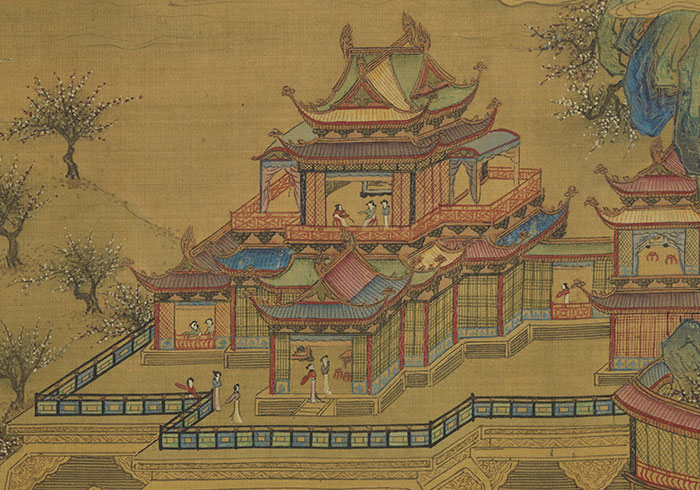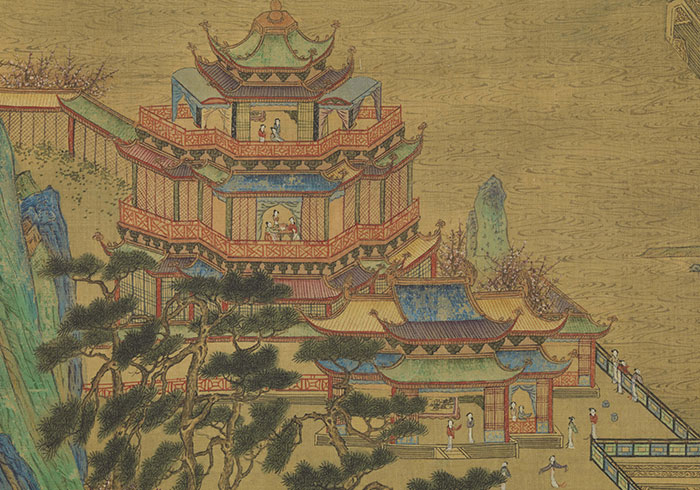Starting from the middle Ming dynasty, Suzhou had already become a center for culture and fashion in the Jiangnan region and the whole country, too. Suzhou-style clothing, furniture, and crafts as well as Suzhou gardens, painting, and even snacks became objects of emulation among competitors in other areas. Suzhou previously had had a long history of considerable "cultural capital," and painters learned and copied from the rich collections in Jiangnan to form their own unique styles, which became a trend among painting circles at the time. For example, "Emperor Minghuang's Journey to Shu" came into the collection of a member in the Xiang family, where the famous Suzhou professional painter Qiu Ying learned and copied from the ancients to create many of his own masterpieces. And with the display and critique of artworks at scholarly gatherings, a taste for and knowledge of painting and calligraphy in Suzhou gradually deepened and expanded.
Suzhou at this time flourished economically, and increasing numbers of people there had the desire and means to collect works of painting and calligraphy. Tempted by the profits to be made, many workshops appeared in the Suzhou area to produce "ancient paintings" for the market, and even some scholar-artists took part in manufacturing these forgeries. The set of hanging scrolls here ascribed to Qiu Ying consists of "ruled-line" paintings done after such works of his as "Towers and Pavilions in Mountains of the Immortals." This subject depicts famous palaces from antiquity complemented by poetry to create a product both opulent in appearance and full of cultural meaning, making it quite suitable for display in a reception hall. This kind of "Suzhou fake" bespeaking the pursuit of fine delicate detail, rich narrative meaning, and deep cultural roots became a new paradigm for "fineries of forgery" that won broad appeal.
Poetry on the Lianchang Palace
- Attributed to Qiu Ying (ca. 1494-1552), Ming dynasty
- Hanging scroll, ink and colors on silk, 66.8 x 37.6 cm
This scroll of painting with poetry on the famous Lianchang Palace of the Sui to Tang dynasties features in its inscription paper mounted at the top twenty-five palace poems purportedly calligraphed by Wen Zhengming (1470-1559). The style of calligraphy and painting in this work is quite similar to another work in the National Palace Museum collection, "Poetry on the Changxin Palace," suggesting they were part of a set of four. Workshops at the time commonly produced paintings in the name of Qiu Ying with calligraphy in that of Wen Zhengming to attract potential buyers. Such blue-and-green landscapes with gold tracing and figures in elaborate towers to be hung in sets of four to decorate a hall must have been an impressive sight to behold.
This hanging scroll combining poetry and painting may have been patterned after "Towers and Pavilions in Mountains of the Immortals," a painting in the National Palace Museum by Qiu Ying with an inscription by Lu Shidao (1517-1580). In fact, the pine trees at the left and palace buildings among them appear similar. The work here, however, lacks the classical elegance and subdued reservation of the original, instead emphasizing stronger colors and complex details. The palace figures in various activities, such as dancing, leaning on a railing, playing a zither, or conversing, present the viewer with many interesting details to study.
Poetry on the Changxin Palace
- Attributed to Qiu Ying (ca. 1494-1552), Ming dynasty
- Hanging scroll, ink and colors on silk, 66.5 x 37.7 cm
This scroll of poetry and painting on the famous Changxin Palace of the Han dynasty has a piece of inscription paper at the top with 25 palace poems allegedly transcribed by Wen Zhengming. This work and "Poetry on the Lianchang Palace" were originally part of the same set, the painting and calligraphy style of both very similar, indicating they also probably came from the same workshop. The end of the palace poetry mentions, "I have seen the four scrolls of gold and green painted by Master Qiu. They are exquisite and beautiful, no less than those of Junior Li (Zhaodao) of the Tang or (Zhao) Bosu of the Song. I have transcribed the hundred palace poems to the immortal painting. Inscribed by Wen Zhengming of Changzhou (Suzhou)." With 25 poems per painting, it would indicate there were originally four hanging scrolls in the set.
Some of the fantastic rocks with heavy washes of blue and green here feature gold tracing for the outlines. The riot of colors and complex palace buildings complemented by pink plum blossoms set the scene for the palace activities of many figures, creating an auspicious and beautiful setting like a realm of the immortals. This scroll as part of a set of four hung in a hall would have created an opulent effect, and it probably was a popular product of workshops at the time.


